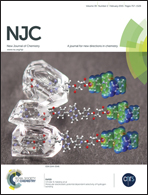Iron oxalate capped iron–copper nanomaterial for oxidative transformation of aldehydes†
Abstract
An efficient, sustainable and green procedure for the synthesis of selective orthorhombic iron(oxalate) capped Fe–Cu bimetallic oxide nanomaterial [Fe(ox)Fe–CuOx] was developed using a sodium borohydride reduction of iron(II) salt in the presence of oxalic acid at room temperature followed by addition of copper sulfate in water. The reported method is a cost-effective chemical route for producing [Fe(ox)Fe–CuOx] nano material at the gram level with a surface area of 78.4 m2 g−1 and a pore volume of 0.141 cm3 g−1. The [Fe(ox)Fe–CuOx] nanomaterials were found to be useful as a recoverable catalyst for the oxidative transformation of an aldehyde to its corresponding ester and acid in presence of hydrogen peroxide.


 Please wait while we load your content...
Please wait while we load your content...